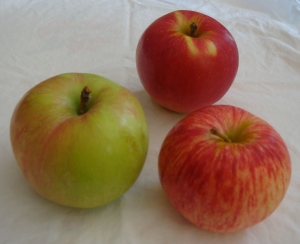
DUCHESS OF OLDENBURG was one of four pioneers among Russian apples in America, along with Alexander, Tetofsky and Red Astrachan. All four were imported by the Massachusetts Horticultural Society around 1835. In European nurseries, the Oldenburg was propagated under the names Charlamowsky and Borowitsky. An extremely hardy variety, Oldenburgs “kept up the hope of prairie orchardists in times of great discouragement,” according to The Apples of New York, Volume II, by S. A. Beach (J. B. Lyon Co., 1905).
The Duchess of Oldenburg is a stunning apple, with beautiful, yellow-and-red striped skin. Its flesh is yellowish, firm, crisp and juicy. A highly aromatic apple, it has excellent culinary qualities.
A relative of the Duchess of Oldenburg is another heirloom, Gravenstein. Beach’s classic apple encyclopedia calls the Gravenstein “perhaps unexcelled by any variety of its season” for culinary purposes. Its origin is unclear, he writes, although “it is undoubtedly of similar origin with the Red Astrachan and Duchess of Oldenburg.” Gravensteins, like the Oldenburg, were imported to the United States by the Massachusetts Horticultural Society in the 1830s.
A newer apple variety is also ready for picking where it is grown in New England orchards. Sansa was developed in New Zealand in 1969 and introduced in the United States in 1986. A cross between Gala and Akane, it is a red, medium large apple. Sansa is a sweet apple, with a deep pink blush on a yellow skin. Its firm flesh is light green in color, and tender and juicy.
Try this moist and low-fat loaf cake that uses applesauce as a substitute for the oil (or butter or shortening). Old-fashioned oats are best to give this cake an even chewier texture and flavor. If available, try using white whole wheat flour in place of the denser whole wheat variety.
Mix early season varieties like Duchess of Oldenburg, Gravenstein, Sansa, and PaulaRed to make your own applesauce. Simply quarter the apples and cook in a saucepan with cider or water until soft, and strain through a food mill. Use several apple varieties to give your sauce and cake a distinctive flavor.
Oatmeal Applesauce Cake
Preheat oven to 350˚.
Pour ¼ c hot water over 1 c oats. Cover and let stand 15 minutes.
In a large mixing bowl, cream:
2 eggs
½ c brown sugar
c sugar or sucralose
½ c applesauce
t vanilla
Combine and add:
1½ c whole wheat flour
1 t baking soda
½ t salt
1 t cinnamon
¼ t nutmeg
Stir in the oat mixture and 1 c raisins.
Pour into a greased and floured 8” x 8” square pan and bake for 50-55 minutes.
2010 New England Apple Harvest Kickoff September 10
The 2010 New England fresh apple harvest will be celebrated Friday, September 10, in a daylong event around the region.
In Massachusetts, Commissioner of Agriculture Scott Soares, Russell Powell, executive director of the New England Apple Association, will visit these apple orchards and apple processing facilities:
10 a.m. to 10:30 a.m. J. P. Sullivan, packing house, Ayer
11 a.m. to 11:30 a.m. Carlson Orchards, with cider-making, Harvard
1:15 p.m. to 1:45 p.m. Red Apple Farm, Phillipston
Beginning that evening through the weekend, the New England Apple Association and Massachusetts Department of Agricultural Resources will sample apples and give away recipes, brochures and other educational materials at a booth at the Sterling Fair.
The fair’s hours are Friday, 5 p.m. to 11 p.m.; Saturday hours are 9 a.m. to 11 p.m.; and Sunday, 9 a.m. to 5 p.m.
Commissioner Soares and Powell will give a presentation on New England apple varieties Sunday at 11 a.m.
Details about events in the other New England states to follow!
1 Comment
Lois Brynes
Great column–Not so sure about all dat sugah in the receipt.
Haven’t you guys heard of Stevia???